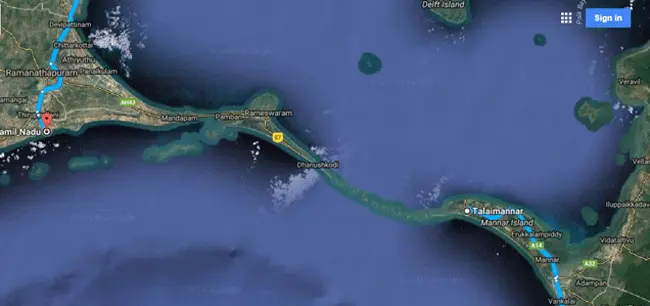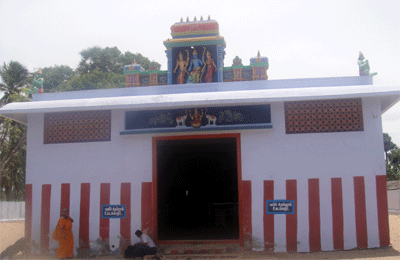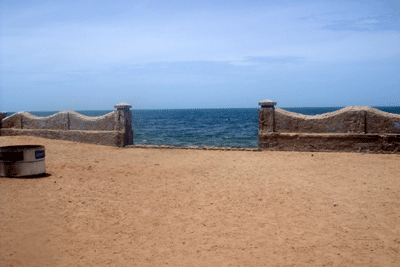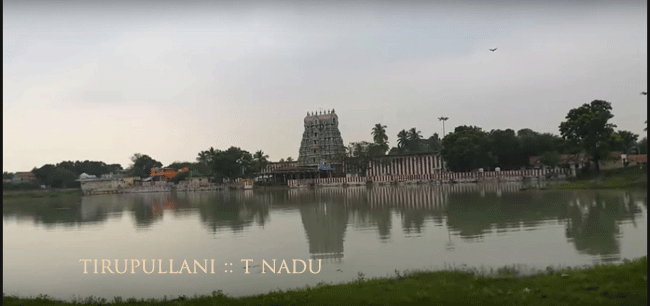
Setukarai
Setukarai is on the seashore of the Bay of Bengal and in the Ramanathapuram district of Tamil Nadu. This place is popular among the pilgrims who are visiting Rameswaram. Pilgrims visit this place to take a bath in the sea which is considered holy and will wash away their sins. There is a heavy rush of pilgrims especially on the new moon day.
 Presently the place is in isolation and the only structure one can find is the temple for Lord Hanuman. According to old timers, the place had a choultry [pilgrims’ inn for stay] a temple for Sri Ganeshji, and a small tank in front of it, which are now in shambles. Nevertheless pilgrims even now come to this holy seashore to take a bath.
Presently the place is in isolation and the only structure one can find is the temple for Lord Hanuman. According to old timers, the place had a choultry [pilgrims’ inn for stay] a temple for Sri Ganeshji, and a small tank in front of it, which are now in shambles. Nevertheless pilgrims even now come to this holy seashore to take a bath.
What is so special about this place? Why this place is called Setukarai? It is very interesting to know the facts and details. This indeed would refresh our memory on knowledge of Srimath Ramayanam.
Sri Ramayana
Sri Ramayana written by Sri Valmiki is known as ‘ Adi Kavyam ’ meaning it is the first poetic work. Ramayana is viewed as the life sketch of Sri Rama an ideal man - ‘ Purushotama ’. It is celebrated in the Sanatana Dharma as a guide for leading an ideal way of living. Sri Rama had lived a life of exemplary human, which should be adopted by all. Ramayana presents the teachings of Vedas in narrative allegory, interspersing philosophical and ethical elements. The characters Rama, Sita, Lakshmana, Bharata, Hanuman, and Ravana are all fundamental to the cultural consciousness of India, Nepal, Sri Lanka, and Southeast Asian countries such as Thailand, Cambodia, Malaysia, and Indonesia.
The life of Sri Rama is known to all and it is also known that Sri Rama under his command built a bridge known as Nala Setu to cross over from the end of this land to Lanka. Our land Bharat is described to be positioned between Nala Setu and the Himalayas as - Aasetu Himachal.
What Sri Rama called Nala Setu is now known as Ram Setu. The Ram Setu Bridge is on the southern tip of our motherland, an identity of our Nation.
Lord of the Sea tells Sri Rama that Nala son of Viswakarma knows the way to build the bridge over the sea. Thus the bridge over the sea was built under the supervision of Nala son of Viswakarma and after completion of the Setu
Greatness of Sri Rama Setu
Valmiki Ramayana Yuddha Kanda chapter 22 verse 78 describes the Nala Setu - bridge after its completion thus: It is massive, wide, well-constructed, splendid, well postured, firmly held together, being splendid, (looked) which looked like a separating straight line in the ocean. The Setu is adored in all three worlds and is very much a sacred spot, capable of washing away major sins.
Sri Kambar retold Ramayanam in poetic form in the Tamil language in the 12th century. Kamban in his narration about the Setu mentions that the very sight of it will take away all the sins and the viewer will become divine. Even the sacred Ganga feels as to why she had not become a part of Setu - implying the divinity attached to Setu.
In Adhyatma Ramayana in Yuddha Kanda, chapter 14 describes the route as retold to Sita by Sri Rama. Verses 5 and 6 tell about the Setu and mentions that it will be worshipped by the entire three worlds, darshan of this Setu will destroy all sins.
Sri Rama Setu from our land
The path taken by Sri Rama from Kishkindha to Lanka is described by Valmiki as Sri Rama narrating the path to Sita Devi while he is returning from Lanka to Ayodhya in the Pushpak Vimana. Yuddha Kanda chapter 123 from verses 15 to 21 tells us the path taken by Sri Rama from Adi Setu to Lanka in the reverse since the narration starts from Lanka. Verse 15 tells the point where Sri Rama’s army had arrived in Lanka and taken rest in the night. Verse 16 tells about the setu that was built over the salt sea by Nala for her sake, which is difficult to execute for others. Verse 17 tells about the beauty of the ocean. Verse 18 describes Mainaka Mountain and its offer to Sri Hanuman. Verse 19 tells that the vanara troops had stayed in the middle of the ocean [implaying it is an island] where Sri Mahadeva had bestowed His grace on him. Verse 20 tells about the place of sacred waterfront in the ocean, called a Setubandha, adored in all three worlds. Verse 21 describes that the spot is very much a sacred spot, capable of washing away major sins. At this very place, Vibhishana the king of demons first came.
 Both Adhyatma Ramayana and Kamba Ramayana describe the route as retold to Sita by Sri Rama. Almost the same descriptions as found in the Valmiki Ramayana is found in these works also without much variation.
Both Adhyatma Ramayana and Kamba Ramayana describe the route as retold to Sita by Sri Rama. Almost the same descriptions as found in the Valmiki Ramayana is found in these works also without much variation.
Adi Setu
Verse 19 as mentioned above in all probability tells about the Rameswarm Island since Sri Rama mentions Sri Mahadeva bestowing His grace on him. Moving northward he tells about the spot and names it ‘Sethubandha’ a place where Vibhishana had taken refuge from him.
In Tamil Nadu, there is a place called ‘Setu karai’ also known as Adi Setu in Ramanathapuram district and located north of Rameswaram. It is believed to be the holy spot from where the bridge to Sri Lanka was built by Sri Rama.
From the above descriptions, it can be observed that ‘Setu karai’ is the ‘Adi Setu’ from where Sri Rama had started building the Nala Setu for crossing over the ocean to Lanka. It is the very same place where Vibishana took ‘Saranagathi’. The very spot is described by Sri Rama as ‘paramam pavitram’ meaning it is very much a sacred spot.
Dharbasayanam of Sri Rama
This is further confirmed by the following events. After Vibhishana saranagathi Sri Rama decides to build a bridge over the sea to cross over to Srilanka. Sri Rama wanted Samudrarajan to give way for building the bridge over it and waited for three days on the mat made ‘kusha’ grass also known as darbha. The spot where Sri Rama waited for Sumudrarajan to respond to his request for three days on the Dharbasanam, is located three kilometers from Setukarai where there is a temple. This place is now known as Tirupullani [meaning ‘scared dharbasanam’ in Tamil].
 After three days of waiting for Samudrarajan, Sri Rama threatens to dry up the sea. Lord of Sea appears in front of Sri Rama and promises to accommodate the building of a bridge over him without disturbing the marine life which he has to protect. He also tells Sri Rama that Nala son of Viswakarma knows the way to build the bridge over the sea.
After three days of waiting for Samudrarajan, Sri Rama threatens to dry up the sea. Lord of Sea appears in front of Sri Rama and promises to accommodate the building of a bridge over him without disturbing the marine life which he has to protect. He also tells Sri Rama that Nala son of Viswakarma knows the way to build the bridge over the sea.
Thus the bridge over the sea was built under the supervision of Nala son of Viswakarma and after completion of the Setu Sri Rama named it ‘Nala Setu’.
Pondering all the above points it is an assuring fact that the head of Nala Setu in our land is on the seashores of Setu Karai. It is no wonder that the name Setu Karai is found in many stone inscriptions and also in ancient Tamil literature.
Temple for Sri Hanuman
As mentioned above presently there is a temple for Sri Hanuman at this place. The temple is facing the sea; there is a strong wall which protects the temple from sea erosion. On the sea shore, many old vigrahas are scattered on the shore, and some of them are mutilated. It suggests that this place must have been busing with activity and many structures might have been there. This may be due to sea erosion or maybe many of them got destroyed. The present temple is very simple, a huge hall constitutes the temple and in the middle of the hall Garbhagraham of Sri Hanuman is situated. While the vigraha of the Lord is ancient, the temple is quite new. Sri Hanuman of this holy kshetra is known by the ‘Setu Bhandhana Sri Jaya Veera Anjaneya’.
Sri Anjaneya of this kshetra is of Nayakars’ period. The sculpture looks more or less the same as found in Vallam near Thanjavur, Ranga Vilas in Srirangam, Rajagopuram of Mannargudi etc. All these moorthams were established by the Nayaks of Thanjavur. The only difference is that the ‘tiruvachi’ for the Lord is also sculptured in stone in those places, whereas in Setukarai there is no stone tiruvachi.
Setu Bhandhana Sri Jaya Veera Anjaneya
The sight of Sri Jaya Veera Anjaneya of this kshetra is great and pleasant. Sri Jaya Veera Anjaneya is nearly seven feet tall in standing posture. Lord is east-facing and looking towards the Nala Setu in the sea. Lord’s lotus feet are seen straight ready to walk down on the setu. Lord is seen wearing ornaments on his ankle. His hip is adorned with chains and a small knife. Lord is a bestowing blessing by raised right hand of His in ‘Abhya Mudra’. His left hand is seen folded towards his bosom and holding the ‘Sowgandika’ flower.
Lord’s glorious face is bright, sharp, and looking straight. The kundal worn by the Lord is seen resting on His shoulders. He is seen with neatly tied hair in the form of ‘kudumi’ [it couldn’t be seen]. The tail of the Lord is coiled and touches the ground (can not be seen). The bright big eyes of the Lord are alert, calm, and pleasant. . A mixture of many moods is expressed by the Lord through His eyes.
Utsavam
Every year Theerthavari Utsavam is held here to commemorate the building of Setu and the proceeding of Sri Rama with his army to Lanka to bring back Sita. The utsava deity of Adi Jagannatha Perumal and Pattabhisheka Rama of Tirupullani are brought in procession to Adi Setu at this seashore.
At the Lord Setu Bhandhana Sri Jaya Veera Anjaneya temple, special abhisheka are performed to both the deities Lord Jagannatha Perumal and Pattabhisheka Rama. Special abhisheka is also performed to Sri Anjaneya of this kshetra. The deities take ‘samudra snanam’ known as ‘theerthavari’.
Location of the temple: "Setu Bhandhana Sri Jaya Veera Anjaneya Temple, Setukarai"
Experience
One should come here to have darshan of Lord Setu Bhandhana Sri Jaya Veera Anjaneya who is guarding the Setu built by Nala for the sake of Sri Rama and Sri Sita. Looking at the glowing eyes of the Lord of Setu Karai which bestows all blessings, is sure to nullify any sorrow of the devotee and mitigate all sins.
SRI HANUMAN THINKS DIFFERENTLY, THINKS FAST
THINKS AHEAD AND ACTS FOR SURE
Ed [December 2016]
Updates: [Jan 2025]
